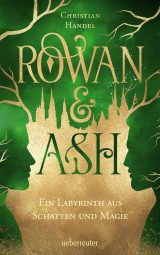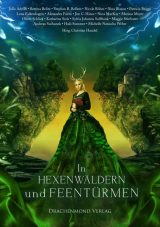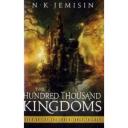 2008 was the year of Patrick Rothfuss, 2009 the year of Peter V. Brett. 2010 might be the year of N. K. Jemisin.
2008 was the year of Patrick Rothfuss, 2009 the year of Peter V. Brett. 2010 might be the year of N. K. Jemisin.
Jemisin manages to strike the delicate balance between originality and comforting familiarity, edginess and universal appeal. Combine it with a strong heroine, a distinctive voice, intricate world building and complex themes and you’ve got an amazing read. The Hundred Thousand Kingdoms is published by Blanvalet as Die Erbin der Welt. Many thanks to Darkstar for allowing me to conduct this interview and to Ms. Jemisin for following my invitation. Welcome to Darkstar’s Fantasy News, Ms. Jemisin.
Would you please give us a brief introduction to The Hundred Thousand Kingdoms?
Basically, the story is set in a world in whose people, due to circumstances revealed over the course of the tale, have enslaved their own gods. The family that controls them has used their power to conquer the world. The first book of the trilogy follows Yeine, a young estranged daughter of this family, as she is drawn back into family — and godly — politics, quite against her will.
I loved reading about Yeine. You made her more interesting than likable and yet she creates great empathy in the reader. This is a rare feat, more common in male protagonists than in female ones. How did you manage this balancing act and which facets of her character are especially important to you?
I think it’s easier to make male characters likable, compared to female characters, because readers tend to give male characters more leeway. For example — I don’t know if this is the case in Germany, but here in the US, behavior that’s derided as “bitchy” in women is usually called “tough” or “assertive”, and admired, in men. There is a racial and class-based component to this as well. It’s something that Yeine is very aware of throughout the novel. Her mother’s people assume that she’s bitchy and violent before she ever opens her mouth, simply by virtue of her background and genetics. She’s judged far more harshly than, say, Scimina — who is more bitchy and violent than she is. But Scimina’s actions are deemed acceptable, even admirable, while Yeine must constantly be on her best behavior in order to get the bare minimum of respect. I just tried to convey her frustration realistically.
Yeine is the heroine of the story and also the first person narrator of the story. Yet, they are not the same. These events happen at different stages of Yeine’s life. I admit it, her voice entranced me. When I finally emerged from the story, my first thought was “How the heck did she pull this off?” Stylistically you eschew conventional wisdom. You use one sentence paragraphs, you break the fourth wall (narrator addresses the reader) and you interrupt the flow of the plot with flashbacks and, though it might sound harsh, infodumps. And yet it works beautifully, creates a wonderful voice and draws the reader in instead of alienating him. Why did you choose this approach and how (the heck) did you pull it off?
(giggle) Thank you! Many of the techniques you mention aren’t particularly innovative, however. They’re commonly used in literary fiction, and in “literary-ish” speculative fiction (e.g. “New Weird” fiction). I read more of that kind of fiction than I do epic fantasy, so I suppose that has influenced my style more. Some readers don’t like it, but in general the book has been well-received.
The Hundred Thousand Kingdoms is an excellent character driven story of politics and relationships. At the same time it’s a treasure trove for readers who like to wrestle with big concepts. The nature of power and the benefits of oppression vs.freedom (of choice) play a big role in your novel. Did you set out to write about this issues or did they just pop up?
Both. The premise of most epic fantasy has never made sense to me — if a world really did have people with magical powers running around, its society would look nothing like medieval Europe (as so many fantasies do). It would look a lot more Orwellian, as people used magic in all the ways that we currently use technology to spy on people, control them, etc. And looking at our own world, where a relatively minor difference in technology during the colonial era caused horrific global-scale oppression and imperialism that continues to this day, it seemed far more logical to make my fantasy world look like that than, say, Middle Earth.
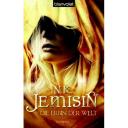 But when I chose to do this, it became natural for the story to focus on the more personal implications of power. Mythology is full of immortal beings falling in love with human beings, but this is usually an allegory or archetype, not a realistic portrayal of a relationship. So I chose to treat it realistically. What possible value could a god who is billions of years old see in a 19-year-old girl? Can a relationship between a master and a slave be anything but wrong? Such complex questions can’t have easy answers. I tried not to give them easy answers, anyway.
But when I chose to do this, it became natural for the story to focus on the more personal implications of power. Mythology is full of immortal beings falling in love with human beings, but this is usually an allegory or archetype, not a realistic portrayal of a relationship. So I chose to treat it realistically. What possible value could a god who is billions of years old see in a 19-year-old girl? Can a relationship between a master and a slave be anything but wrong? Such complex questions can’t have easy answers. I tried not to give them easy answers, anyway.
Your novel is marketed to fantasy readers and romance readers. The latter surprised me a bit. While the relationship thread is important, it doesn’t take up a lot of space and I wouldn’t call it “romantic” in the sense of the Romance genre. How did the romance community receive your book and what were your experiences with them?
I just attended the Romantic Times Booklovers’ Convention a few months ago — my first time interacting with the romance readership. And I discovered that romance readers are very, very eclectic and voracious. They don’t limit themselves to books that are primarily “about” romance. They will read anything, as long as it has engaging characters and a well-depicted relationship. So The Hundred Thousand Kingdoms has been very well-received there.
The gender stereotype exists that men won’t buy books with too much gooey girly stuff in them. If someone hesitates to buy your book because of the relationship thingie, what would you tell him (or her)?
Don’t read it. =) Really. If a reader is that irrational about seeing relationships depicted in fiction (and I do think it’s irrational — it’s not like only women are capable of love, sex, etc.), then they’re going to react badly to my book regardless of how well it’s written. I don’t want to traumatize anybody. There’s plenty of fantasy out there that either ignores relationships or handles them in macho ways, so they should stick to what makes them comfortable.
I will say that most of the male readers I’ve spoken to don’t seem to have a problem with the romance. In fact, most of the reviews I’ve seen by men have actually commented positively on how hot the romance is. =)
Whitewashing covers (people of colour are depicted as white for marketing purposes) was a hot topic on the blogosphere recently. How did you react when it happened to your book? After all Yeine’s mixed racial background is central to the story and you’re a woman of colour yourself.
I’ve been telling myself that the woman depicted on the cover of The Hundred Thousand Kingdoms is Kinneth, Yeine’s dead mother.
Orbit is known for its striking covers. The one for The Hundred Thousand Kingdoms is no exception. Originally a different visual motif was planned. Why did it change and are you happy with the results?
I think good cover art should complement the text and allow readers to impose their own imagination/identification on the character depicted there, if a character is depicted. That can be done in a variety of ways. Leaving a character off the cover is definitely an option, commonly used in epic fantasy. This is why I actually asked the folks at Orbit to consider using Sky (the palace) as the main image, because I thought it would send a nice “this is epic fantasy!” signal. Plus I thought it would be very striking — a palace on a stick! I’m pleased that they listened to me.
However, there is also a human figure on the Orbit covers — near the top, above the palace, one can see a shadowed face. (A lot of people miss it at first. The artist did great subtle work there.) To me that face is Nahadoth, but many readers seem to think it’s Yeine. It works either way and I’m fine with that ambiguity. It doesn’t contradict the text, or the reader’s imagination.
Orbit initially marketed the book to retail buyers, distributors, and reviewers — the “gatekeepers” of the industry, in some ways more important than readers — with Yeine featured prominently on the cover. (You can view the preliminary cover on my website, here)
I liked that image, especially because it prominently and accurately depicted Yeine as a tough-looking brown-skinned woman. However, that made the image too cluttered, so Orbit reworked the cover to make it less busy, and they removed Yeine. I was fine with this. The final Orbit cover turned out beautiful.
On your blog you’ve stated that you don’t want to be shelved in the African American section of a bookstore and David Anthony Durham, author of Acacia, has said something similar. Would you please explain the reason behind this?
I actually explained my reasoning in that post. But to briefly summarize, the African American section serves no useful purpose — it did once, but now it actively harms most authors whose works are placed in it. And the existence of this section assumes that all readers care about is the race of the author. I don’t think that’s true of most readers. I want to sell my book to most readers.
Authors tend to face many trials and tribulations before signing their first contract. What was your journey like and how does the reality of being a published author match up with your expectations?
The journey is ongoing. I’m still too new to it to really explain what it’s like! I will say that being a published author is by no means glamorous and is actually harder than being unpublished in some ways. I used to write when I wanted; now I have to write every day, sometimes all day, in order to finish books on deadline. I have to be creative on demand. I have to travel more than I really like, and spend more time promoting myself than I’m comfortable with. But that’s part of the job these days. I’m adjusting to it.
I’ve made the observation that in Science Fiction and Fantasy many female authors seem to pick gender neutral synonyms and in Urban Fantasy it’s the men who use them. Why did you choose to use your initials?
Honestly, it wasn’t intended to conceal my gender. That’s less of an issue in fantasy than in science fiction — I think fantasy is slightly female-dominated these days. It’s just that I have another career (as a career counselor) and was trying to establish some barriers between the two. So since I use my full name there, I chose to use initials in my writing career.
Translating fantasy always represents a unique challenge. Were you in contact with your German translator Helga Parmiter and did anything surprise you about the process?
I haven’t had any contact with the German translator, so I can’t really speak to the process.
Apart from the States and Germany, where else are you published?
The Hundred Thousand Kingdoms will be published in Poland, Spain, and France. It is already available in all predominantly-English markets (US, Canada, UK, Australia, New Zealand, and India).
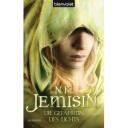 In Germany Die Erbin der Welt has been out only for a short time, but you’ve already finished the first draft of the final novel in your trilogy (insert a little happy dance). What are your next writing projects or do you want to take a breather for a while?
In Germany Die Erbin der Welt has been out only for a short time, but you’ve already finished the first draft of the final novel in your trilogy (insert a little happy dance). What are your next writing projects or do you want to take a breather for a while?
I have bills to pay, so I won’t be taking much of a breather! I’m currently revising one of my earlier epic fantasy novels, and beginning work on a YA novel I’ve been planning to write for some time.
Thank you, Ms. Jemisin, for patiently answering my sometimes provocative questions. It was a pleasure to do the interview. Good luck for your writing career and other endeavors. Do you have any final words?
I would love to hear from German readers about how they like The Hundred Thousand Kingdoms! Please feel free to post comments or send email via my Website.
If you enjoy High Fantasy, The Hundred Thousand Kingdoms will rock your socks off. While I’m searching for mine, I’m eagerly anticipating the second instalment. The Broken Kingdoms and Die Gefährtin des Lichts are both scheduled for November 2010 in their respective countries. Happy reading.
© hwm
